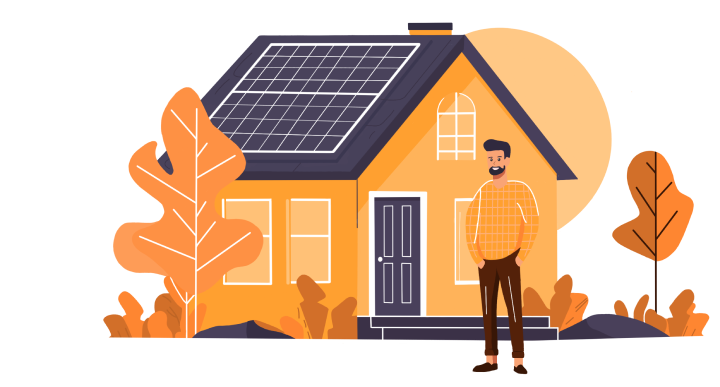A realistic solar panel installation cost breakdown is crucial when considering the switch to sustainable energy. As more people choose renewable power to save on electricity bills, having an idea of the average solar panel installation cost helps you plan better.
Solar Energy Host is here to make this easier by providing clear information and connecting you with trusted solar power installers. Read on as we explain how to calculate your energy needs, pick the right residential solar panels, find local incentives and get competitive installation quotes.
Step #1: Calculate your energy needs.
It's important to know how much electricity you use each day before you can get a solar panel installation cost breakdown. Look at your past utility bills to see your household's energy patterns, including peak usage times and seasonal changes. A home energy monitor can give you real-time data, helping you find ways to reduce usage.
Once you've calculated your electricity usage, you can estimate how many solar panels you'll need. Here's how to get this done:
- Determine panel wattage. Choose the wattage you need for your roof and solar panel installation, typically between 250 and 400 watts for residential use.
- Calculate daily energy consumption. Add up your total daily electricity usage in kilowatt-hours (kWh).
- Assess peak sunlight hours. Find out how many hours of sunlight your location receives on average each day. Ideally, solar is a great option for homes that get around four hours of sunlight daily.
- Compute the required solar power. Divide your daily kWh consumption by the peak sunlight hours to calculate the total kilowatts (kW) needed from your solar panels.
- Estimate the number of panels. Divide the total kW needed by the wattage of one solar panel. This gives you the number of panels required to cover your energy needs.
Take note that your roof size and how much direct sunlight it gets can influence the total number of panels you can install and the solar power installation cost.
If you're unsure or need professional help, it's best to reach out to a local provider who can give you more personalized advice about whether your home is a good candidate for solar panels and the number of panels you can install.
Step #2: Choose the right solar panel for your needs.
Consider the efficiency, cost and your site's physical limits when choosing solar panels to get the closest solar panel installation cost breakdown. A panel's efficiency shows how well it turns sunlight into electricity.
The cost of solar panels with high efficiency may be higher but they generate more power in less space, which is great for small roofs. Also, consider your roof's direction and any shading to pick the best panel type for maximum energy output.
Different solar panels meet different needs:
- Monocrystalline panels. These are ideal for small roofs because they are highly efficient and sleek. They convert more sunlight into electricity, use less space and last longer. They are more expensive but a good investment if your roof space is limited.
- Polycrystalline panels. These are suitable for larger roofs where space isn't a concern. They are less expensive in terms of solar power systems prices but less efficient. They offer a balance between cost and performance, making them practical for budget-conscious homeowners with more roof area.
When it comes to solar panels, choose the type that fits your space, budget and energy needs to get the best performance from your solar system and a solar panel installation cost breakdown that fits your requirements.
Step #3: Don't leave money on the table—find solar incentives near you.
Solar incentives can lower the solar panel installation cost breakdown, including the cost to install solar, making it more affordable. State and federal programs offer solar energy financing support like grants, tax credits and rebates, which can help with installation costs, reduce your taxes and give you money back.
The Federal Investment Tax Credit (ITC), for example, lets you deduct part of the solar panel pricing from your federal taxes, reducing your expenses. But other incentives vary by location, so it's best to check local government and utility websites to find what solar financing options and other offers are available.
Step #4: Check solar installation quotes from different providers.
With Solar Energy Host, it's easy to get quotes from top local solar providers so you can compare prices, solar panel installation cost breakdown, service quality and project timelines. With this, you can avoid overpaying, get better service in terms of the solar installation process and gain more solar panel benefits. This will also give you an idea about the cheapest solar installation available.
Assess the expertise, warranty options and customer service of solar panel installers. Their experience, warranty length and after-sales support can affect your satisfaction. Check customer reviews to learn about each provider's reliability and service quality.
Having several quotes also gives you bargaining power to negotiate better terms or discounts. When providers know you're comparing options, they may offer a clearer solar panel installation cost breakdown and more competitive prices or conditions, reducing your costs. To negotiate effectively, know what you want and understand typical market prices.
Frequently Asked Questions (FAQ)
What is the cost per watt for solar panels, and how is it calculated?
Calculating the cost per watt for solar panels is simple. Divide the total cost of your solar system by its capacity in watts. For example, if your system costs $10,000 and has a capacity of 5,000 watts, the cost per watt is $2. This metric helps you consistently compare prices across different solar systems.
How do solar panel installation costs compare to traditional energy bills over time?
While there is an upfront cost for solar installation, this investment pays off over time through lower energy bills. As a solar panel system lasts for around 25 to 30 years, the total savings can outweigh the initial cost. As electricity prices from traditional sources rise, the financial benefits of solar become even clearer.
How do I estimate the total cost of solar installation for my specific home?
First, look at how much energy your household uses, which you can find on your utility bills. Then, consider the type of solar panels, installation fees, available incentives and any extra equipment like batteries. Solar Energy Host can help you get competitive quotes from local providers to create an accurate budget.
Simplify solar with Solar Energy Host
At Solar Energy Host, we make going solar simple and worry-free. Like many eco-conscious homeowners, you can lower your electricity bills using our platform. Just enter some basic information, compare quotes and choose from the top local solar providers.
It's an effortless way to switch to sustainable energy. Start saving today—see how much a solar power installation at your home will cost.



















